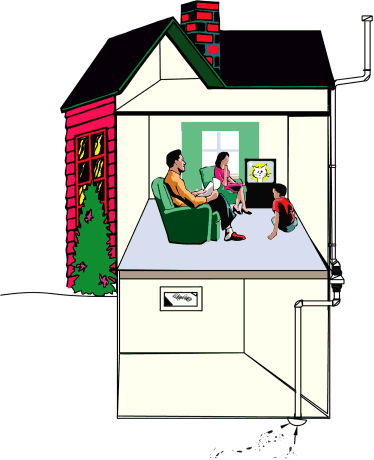Endicott Soil Vapor Project
Ventilation system minimizes exposure in buildings affected by soil gas
IBM is installing ventilation systems in buildings in Endicott, New York, where air sampling has detected volatile organic compounds (VOCs) in indoor air associated with the company's former manufacturing facility. The ventilation system is designed to minimize peoples exposure to VOCs from soil gas by capturing the gas before it enters the building. Tricholorethene (TCE) is the contaminant of greatest concern since it was found at the highest concentrations in indoor air and groundwater.
The likelihood of health effects associated with exposure to TCE at the levels measured in local buildings is low. The levels of TCE measured in indoor air are lower than the levels that cause health effects in people and animals.
Additional air sampling of buildings surrounding the former IBM facility is ongoing. The company will continue installing ventilation systems in buildings where TCE and other VOCs were detected and in nearby buildings where levels are expected to be similar to those where the air was tested.
This fact sheet answers questions about IBM's plans to remediate affected buildings in Endicott. It discusses the findings of is recent sampling of soil gas and indoor air in the neighborhood surrounding its former facility. It also provides health-related information about exposure to TCE and other VOCs that are being addressed as part of this remediation plan.
Ventilation systems are designed to minimize exposure from breathing soil gas. The system captures soil gas before it enters a building and redirects it away from the basement to a point above the roof.

By sealing foundation cracks and installing ventilation systems, soil gas from contaminated groundwater beneath the foundation is captured before it enters a building.
Background of the Remediation
IBM used certain VOCs as solvents, which entered the groundwater from leaks and spills at its former facility. The company is cleaning up groundwater contaminants as part of an ongoing remediation plan required by the State of New York. In 2002, the company began sampling air in soil gas and indoor air of nearby buildings because the New York State Departments of Environmental Conservation and Health required the company to evaluate whether vapors from groundwater contaminants could be moving through the soil into the basements of buildings near the former IBM facility. IBM developed this assessment and remediation plan in conjunction with the New York State Departments of Environmental Conservation and Health.
How is it decided which buildings need ventilation systems?
IBM will install a ventilation system in any building where air quality is affected by soil vapor from beneath the structure. By comparing indoor, outdoor and sub-slab air samples, they determine if indoor air quality is affected by soil vapor. Systems will be installed in buildings where TCE or other soil vapor contaminants are detected and in nearby buildings where levels are expected to be similar to those that were sampled.
What levels of TCE contamination have been found?
To date, IBM has tested the soil gas and indoor air at more than 300 properties. TCE was the most commonly found contaminant in indoor air, at levels ranging from 0.18 to 140 micrograms per cubic meter of air.
Will anyone in my household get sick from living in a building with levels of TCE similar to those measured in the indoor air of nearby buildings?
The likelihood of health effects associated with exposure to TCE at the measured levels in local buildings is low. The highest levels of TCE measured in indoor air in the buildings sampled to date were about 300 times lower than the levels that cause effects on the central nervous system in humans.
What about other contaminants?
Other contaminants have been detected in soil gas and indoor air less frequently and at lower levels. The sample results collected to date show that these VOCs are below levels that would cause health effects. These contaminants include tetrachloroethene, cis-1,2-dichloroethene, 1,1,1- trichloroethane, 1,1-dichloroethene, 1,1- dichloroethane, and Freon 113.
What is TCE?
TCE is a man-made chemical used as a solvent to degrease metal machinery parts. It also is used to make other chemicals. TCE also can be found in some household products such as typewriter correction fluid, paint removers, adhesives and spot removers. It is a liquid at room temperatureand evaporates into the air. It has a somewhat sweet odor.
What kinds of health effects are caused by TCE?
In people, breathing high levels of TCE can cause adverse effects on the central nervous system, including dizziness, headache, sleepiness, nausea, confusion, blurred vision and fatigue. Some studies of people exposed for long periods of time to high levels of TCE in workplace air or exposed to TCE and other chemicals in drinking water showed an increased risk for certain types of cancer and effects on fetal development. We do not know if these observed effects are caused by TCE or some other factor because of limitations associated with these studies. TCE has been shown to cause cancer in laboratory animals that were exposed to high levels of the chemical over their lifetimes. Long-term exposure to high levels of TCE also causes central nervous system, liver, kidney and developmental toxicity in laboratory animals.
Is the Village public water supply suitable to drink?
Yes. The Village of Endicott's water supply is monitored and complies with New York State drinking water standards. The majority of the Village's drinking water comes from the Ranney well field, which is a treated water supply. The Village also occasionally takes water from the South Street well.
What are the next steps?
Because exposures have occurred in this community, the State Health Department will evaluate approaches that may be useful for understanding if TCE exposures have affected the health of residents. The State Health Department will work with the community to develop any health studies.